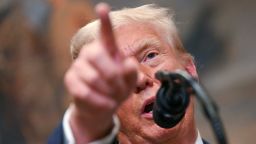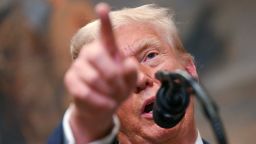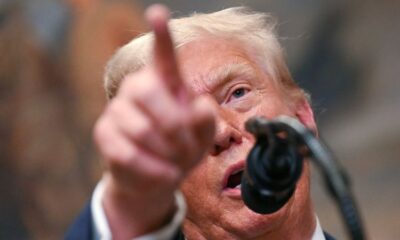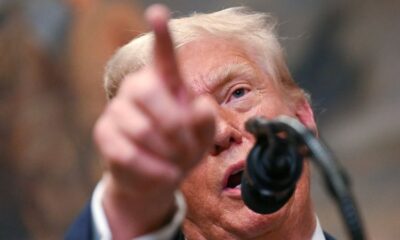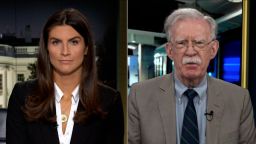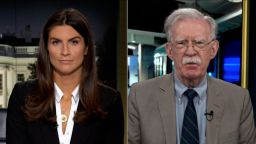Education
Trump Responds to Russian Nuclear Threats with Submarine Deployment
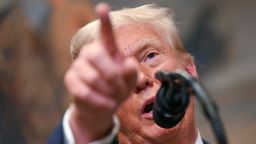
President Donald Trump has initiated the repositioning of two US nuclear submarines, responding to provocative remarks from former Russian President Dmitry Medvedev. This move comes amid escalating tensions surrounding the ongoing conflict in Ukraine and Medvedev’s recent social media outbursts. The exchange highlights the precarious nature of US-Russia relations and raises questions about the motivations behind Trump’s actions.
In a series of posts, Medvedev criticized Trump’s ultimatum to Russia regarding a peace deal in Ukraine, describing it as “a step towards war” not only with Ukraine but “with his own country.” He also warned Trump to remember the dangers of Russia’s automatic nuclear retaliation system, known as the “Dead Hand.” This comment, while alarming, drew skepticism from US officials, including Marco Rubio, Trump’s Secretary of State, who noted that Medvedev’s influence in Moscow has diminished significantly.
Trump’s decision to deploy nuclear submarines appears to be a strategic maneuver aimed at projecting strength without directly confronting Vladimir Putin, the current Russian leader. By engaging with Medvedev, often referred to as “little Dima” in Russia, Trump may seek to enhance his tough-on-Russia image while avoiding a direct clash with the Kremlin’s actual power brokers.
The US president stated that the submarines would be “positioned in the appropriate regions” in response to Medvedev’s “foolish and inflammatory statements.” Yet, the US maintains a fleet of nuclear submarines that routinely patrol the world’s oceans, armed with a substantial number of nuclear warheads capable of reaching Russian targets even without any repositioning.
As negotiations continue, Steve Witkoff, Trump’s envoy to the Middle East, is set to meet with Russian officials in the coming days. These discussions will likely focus on achieving a ceasefire in Ukraine, especially as a deadline for a peace agreement approaches. The Kremlin has remained steadfast in its military objectives, and observers doubt that heightened nuclear rhetoric will alter its stance.
The timing of Trump’s nuclear deployment also raises speculation about its domestic implications. As he grapples with various political challenges, including potential sanctions on countries that purchase Russian oil, the emphasis on nuclear readiness may serve as a distraction from pressing issues at home.
While the rhetoric surrounding nuclear capabilities between the US and Russia is indeed concerning, analysts believe that it does not indicate an imminent nuclear confrontation. The relationship between Washington and Moscow remains strained, but both sides are unlikely to escalate tensions to a point of no return.
Ultimately, Trump’s actions reflect the complexity of international diplomacy, where statements and posturing can overshadow substantive policy changes. The coming weeks will reveal whether this strategy proves effective in both foreign and domestic arenas.
-

 Lifestyle2 weeks ago
Lifestyle2 weeks agoBelton Family Reunites After Daughter Survives Hill Country Floods
-

 Technology2 weeks ago
Technology2 weeks agoDiscover the Top 10 Calorie Counting Apps of 2025
-

 Education3 weeks ago
Education3 weeks agoWinter Park School’s Grade Drops to C, Parents Express Concerns
-

 Technology3 weeks ago
Technology3 weeks agoByteDance Ventures into Mixed Reality with New Headset Development
-

 Technology3 weeks ago
Technology3 weeks agoMeta Initiates $60B AI Data Center Expansion, Starting in Ohio
-

 Technology5 days ago
Technology5 days agoHarmonic Launches AI Chatbot App to Transform Mathematical Reasoning
-

 Technology2 weeks ago
Technology2 weeks agoMathieu van der Poel Withdraws from Tour de France Due to Pneumonia
-

 Lifestyle3 weeks ago
Lifestyle3 weeks agoNew Restaurants Transform Minneapolis Dining Scene with Music and Flavor
-

 Technology3 weeks ago
Technology3 weeks agoRecovering a Suspended TikTok Account: A Step-by-Step Guide
-

 Technology3 weeks ago
Technology3 weeks agoGlobal Market for Air Quality Technologies to Hit $419 Billion by 2033
-

 Health3 weeks ago
Health3 weeks agoSudden Vision Loss: Warning Signs of Stroke and Dietary Solutions
-

 Technology3 weeks ago
Technology3 weeks agoTrump Faces Internal Struggles Over Epstein Files Handling

